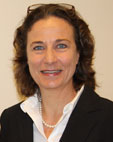Elisabeth Massoni
Elisabeth Massoni is the director of CEMEF (Materials Forming Center). CEMEF belongs to MINES ParisTech institution and is located in Sophia-Antipolis in the south of France. Research is multidisciplinary at CEMEF, from fundamental research to applications. Based on fundamental studies, the centre's research activities are focused on physical and mechanical understanding of the principal aspects of materials processing and forming. Numerical codes on metal and polymer forming are then developed in the laboratory and industrialised by the software company Transvalor. The specificity of these codes is the different level of coupling: multi-scale, multi-materials and multi-physics. Around 160 people are working at CEMEF, about 60 permanent staff and 70 doctoral students.
The field of expertise of Elisabeth Massoni is on numerical simulation of metal forming processes (thin sheet forming, flow forming, hemming,..) and heat treatment. It concerns mainly the development of large strain behaviour, plastic anisotropy, nonlinear isotropic and kinematics models. These activities are mainly conducted through Phd research projects (around 25) in close collaboration with the industry in different economic sectors (automotive, aeronautics,…).
Elisabeth Massoni is also member of the board of CSMA (French Computational Structural Mechanics Association), ESAFORM (European Association of Material Forming), Pégase French Aeronautices cluster. She is also president of a SF2M (French Society on Metallurgy and Materials) Commission on Thin Sheet Metal Forming and Superplasticity.
New challenges in numerical simulation of forming processes: multi-scale and multi-physics approaches
Elisabeth Massoni, Pierre-Olivier Bouchard, Marc Bernacki, Elie Hachem
CEMEF Mines ParisTech
The industry must demonstrate the ability to develop, process and join increasingly diverse and complex materials, in a well-controlled manner and applicable to different economic sectors such as aerospace, nuclear, defense and energy. To meet these requirements, processes evolve and new ones appear. Another demand of the industry is to work across the entire range of manufacturing steps or life cycle of products: from the development of the material and its forming processes to recycling without forgetting the steps of heat treatment, assembly and usage properties. This serves two purposes:
- better control of the material flow and energy and giving a global vision of the transformation of materials,
- but above all, taking into account the effects of the inheritance of properties, structures, defects from upstream to downstream processes.
Multi-physics and multi-scale modeling are a key driver in such actions. We will give examples of numerical challenges that have missions to meet these industry needs. In metal forming industries, the elimination of internal defects is a prerequisite to avoid catastrophic failure of parts. Therefore, advanced numerical methods such as the levelset method to describe the interface followed within a framework of finite element formulations can be used to model the germination, growth and void closure in the ductile damage. The same levelset method can also be used to simulate grain growth and polycrystalline microstructures mobile interfaces. Finally heat treatment, such as heating and quenching, are also of major importance in the workpiece life and must be simulated accurately by coupled modeling of several fields of physics: mechanics, thermics, electromagnetism, chemistry, metallurgy.
